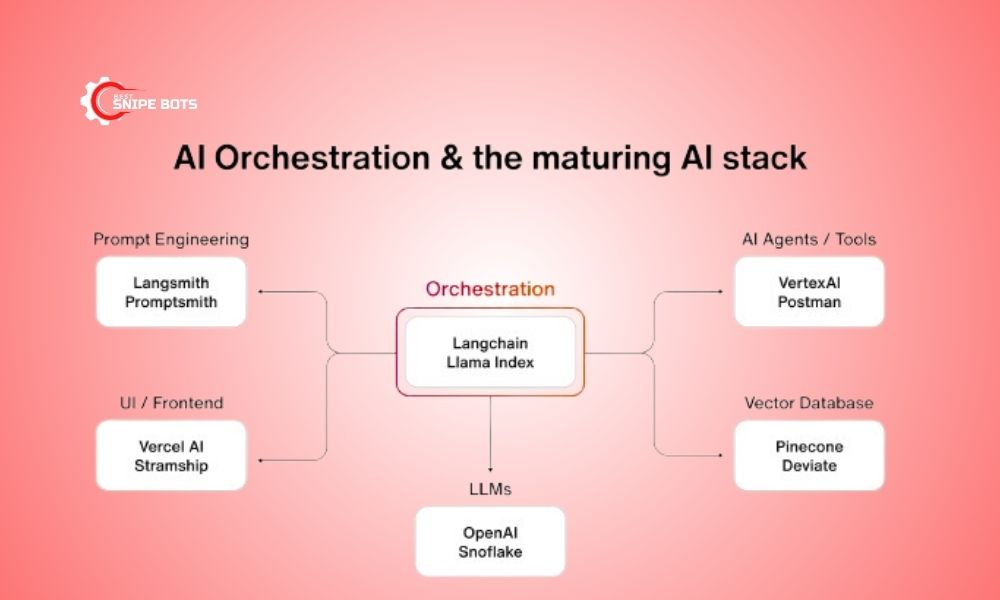An AI agent orchestration framework serves as a central architecture, acting like a conductor to coordinate the complex interactions between different AI components. It connects large language models (LLMs), vector databases, tools, and user interfaces to create intelligent, autonomous AI applications capable of seamlessly executing multi-step tasks.
What is an AI agent orchestration framework?
In the rapidly growing AI ecosystem, building intelligent applications is no longer just about calling a single Large Language Model (LLM) API. Instead, these applications require a combination of many distinct technologies. This is where an AI agent orchestration framework plays its crucial role.
Simply put, it is a structured framework that helps organize, connect, and manage the workflow between various components within an AI system.
Imagine you’re building an AI assistant that can conduct market research. This assistant needs to understand your request, search for information in an internal database, access external tools for new data, and then synthesize and present the results in an understandable way. A powerful AI agent orchestration framework would be the brain controlling this entire complex process, ensuring every component works together in harmony.
Key components in a modern AI stack
Based on the diagram of a maturing AI stack, an AI agent orchestration framework acts as the nucleus connecting the following members:

Orchestration layer
This is the center of the entire system. Prominent frameworks in this layer include Langchain and Llama Index. They provide the tools and libraries to build “chains” and “agents.”
- Chains: Allow for combining multiple LLM calls or other utilities in a logical sequence.
- Agents: Use an LLM to decide which actions to take and in what order, allowing the AI to interact with its environment.
This orchestration layer is the heart of an AI agent orchestration framework, dictating how information is processed and routed.
Large language models (LLMs)
This is the engine that provides natural language processing power. Typical examples are models from OpenAI or Snoflake. The orchestration framework sends prompts to the LLM and receives results to process the next steps. The LLM is the component that provides the core intelligence for the system.
Vector database
For an AI to retrieve relevant information from a large amount of data (e.g., internal documents, chat history), we need a vector database. Tools like
Pinecone or Deviate help convert text data into numerical vectors and store them. When a question is asked, the AI agent orchestration framework will query this database to find the most semantically relevant information, which is then provided to the LLM as context. This process is known as Retrieval-Augmented Generation (RAG).
AI agents / Tools
A powerful AI application doesn’t just answer questions; it can also perform actions. This is the task of agents. An AI agent orchestration framework allows the LLM to use external tools. For instance, it could use VertexAI to perform complex machine learning tasks or use Postman to interact with external APIs (e.g., checking the weather, booking a flight). This transforms the AI from a simple language model into a capable, action-oriented agent.
Prompt engineering
The quality of the output from an LLM heavily depends on the quality of the input prompt. Tools like Langsmith and Promptsmith help developers build, test, and optimize prompts. They are an indispensable part of ensuring the AI agent orchestration framework operates effectively and gives precise instructions to the LLM.
UI / Frontend
Finally, for a user to interact with the AI application, we need a user interface. Platforms like Vercel AI or Stramship provide toolkits to quickly build user interfaces, helping to display results and receive input from the user in an intuitive way.
Why is an AI agent orchestration framework important?
As AI applications become increasingly complex, manually managing the interactions between components becomes unfeasible. An AI agent orchestration framework provides a clear structure that helps to:
Reduce complexity: It abstracts complex interactions into manageable components.
Increase modularity: It makes it easy to swap or upgrade individual components (e.g., changing the LLM, replacing the vector database) without affecting the entire system.
Accelerate development: It provides pre-built tools and templates to build sophisticated applications faster.
Create more powerful applications: It enables AI to not only “talk” but also “do” by connecting to external tools and data.
Clearly, the AI agent orchestration framework is not just a trend but an essential component in building the next generation of intelligent and autonomous AI applications.

In conclusion, the AI agent orchestration framework is the essential glue for the modern AI ecosystem, allowing individual components to work together harmoniously to solve complex problems. To stay updated with the latest in AI technology, be sure to follow Best Snipe Bots for more insights.